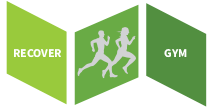Ankle ligament injury / Sprained ankle / Distorsio pedis
Rehab training of the injury
Rehab 1 – Rehab 2 – Rehab 3 – Rehab 4
Focus of training the rest of your body so you do not lose mobility, stability, or strength in general. Find out what you are able to do, and exercise at the level that suits you. Training the rest of the body accelerates the healing process of injury, both because of the increased nerve activity and because of the circulation.
Description
Ankle ligament injury also called sprained ankle is one of the most frequently occurring musculoskeletal and sports related injuries. It is estimated that approximately only 10-20% of all cases get medical treatment, for this reason injury treatment in the acute phase is extremely important. Sprain (distortion) usually occurs (90% of the time) when placing weight on to the foot while turning inward (supination strain). Four reasons for this are:
- The foot does not properly correct instability if the joint is weak and there is too little sensory feedback.
- The leg goes further down, preventing the foot from tipping out.
- The outer ligaments are much weaker than the inner.
- The nervous system is tired and reacts too late, often seen at the end of a match or exercise.
You have three ligaments on the outside of the ankle, all of which are weak. The bigger the trauma, the more ligaments get broken. First the frontal ligament breaks, then the ligament just under the outer malleolus, and finally the back ligament.
Symptoms
- Pain during weightbearing and movement of the ankle.
- Swelling and soreness.
- Ecchymosis (subcutaneous bleeding) / bruising and possibly discoloration of the skin most commonly located under the injury.
- The foot feels loose (usually isn’t felt in acute injury).
Examination
A physician, physiotherapist, sports injury therapist, chiropractor, osteopath can usually perform an examination to determine whether the ankle is sprained or whether it’s broken, which is uncommon. REMEMBER, if you have the least bit of doubt about how serious the injury is, you should always contact a healthcare professional, a doctor or go to the emergency room.
The professional will typically examine by:
- Analysis / inspection / palpation / move the test.
- Anterior draw test (ATFL) and posterior draw test (PTFL) (cannot be completed if the joint is swollen).
- Direct, indirect compression test and a tuning fork test to find out if there is a fracture.
- Stork test (> 12 sec).
- X-ray examination can support the diagnosis (possibly with a draw test).
Treatment
Throughout the last 30 years, therapists, doctors, hospitals, coaches and practitioners themselves have been trained in the ice principle, RICE / RICEM. Over the last couple of years, it has been well documented that ice actually has a negative effect on the healing process. Read more about acute injury treatment.
Akut fase (0-48 timer)
PER (performed only by trained therapists) or the MCE principle (mobilization, compression and elevation).
- M = Move your foot as much as possible without strain to increase circulation; removing waste products and bringing nourishment to the area. This can be done by making circular movements and pumping exercises with the foot.
- C = Use a compression bandage so that the area does not swell up more than necessary. REMEMBER not to make the bandage too tight! You can choose to loosen the dressing 2-4 times a day and re-wrap.
- E = Avoid weightbearing for the first two days, and keep your leg elevated so that the waste products are removed from the injured area by the blood circulation.
- DO NOT APPLY ICE! Ice prolongs the healing process.
Subacute (day 3-100)
Start rehab 1 and follow the rehab programs until your injury has healed. The healing process for a ligament injury may take up to 9 months, so be aware; that although there is no pain, mobility is normal and you feel able to resume your sport, your ligament is still weakened, which is why rehabilitation rehab 4 should be continued to some extent. In order to support a faster recovery, the following points can help you:
- Rehabilitation Tape.
- Cryotherapy (ice massage for 9 min).
- TENS.
- Ultrasound (continuous / pulsating), 3 Mhz, 0.5-1.5 W cm2.
- Kinesiology tape.
- K-Laser.
- Thermo (heating pad for circulation).
- Traumeel ointment or tablets (2 tablespoons 3 g. daily for 9 days).
Standing Stork Balance can give you a picture of how important your rehabilitation will be to ensure that ankle is not re-injured.
(You have 3 attempts).
1. Stand in a generally broad position and put your hands on your back.
2. Straighten the back.
3. Look straight.
4. Bend the knee on the non-injured leg so you’re standing on one leg and both knees are next to each other.
5. Find your balance.
6. Close your eyes and keep your balance as long as possible.
<12 sec. = none / very bad balance and coordination (must be rehabilitated).
12 – 30 sec. = poor balance and coordination (should be rehabilitated)
30-60 sec. = Normal / Good balance and coordination.
> 60 sec. very good balance and coordination.

Social Medier